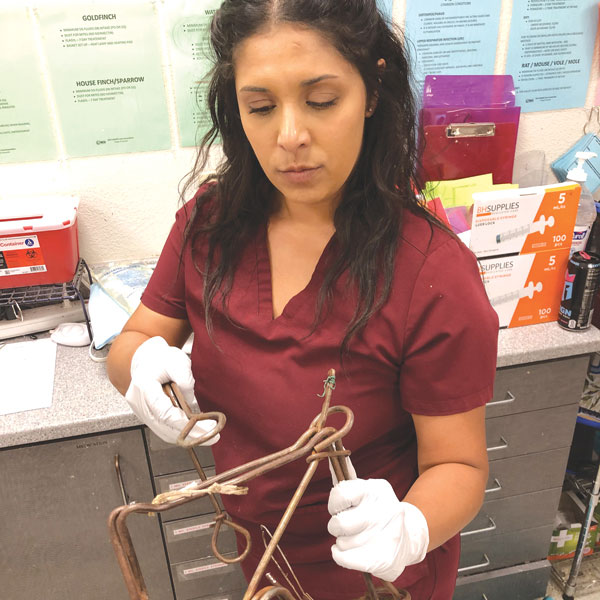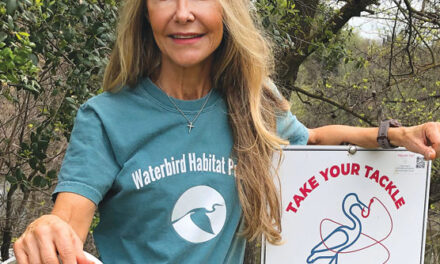The heavy metal trap clamped down on the opossum’s neck with the power of a jackhammer.
Spring-loaded to deliver deadly force, the trap drove the young marsupial over a wood fence separating two Elk Grove homes where he hung for 24 hours before the neighbor called for help.
The old-style, body-gripping device “crushed his esophagus,” says Sandra Foreman, animal care manager with the Wildlife Care Association of Sacramento. “It was tight around his neck, like someone strangling you.”

After sawing through the thick metal bars to free the animal, Wildlife Care staff and volunteers were hopeful. The opossum began eating and drinking.
He died two days later.
Body-gripping devices, like the one used to trap the opossum, are illegal in California.
When a game warden with the California Department of Fish and Wildlife investigated the crime, he found “minor issues that resulted in a warning,” says Patrick Foy, a captain with Fish and Wildlife.
A opossum illegally trapped and hanging by his neck for hours was dismissed as a “minor issue.”
No citation was given. No report filed with the Sacramento County District Attorney’s Office.
Two months later, another illegal trap was mounted on the same Elk Grove fence.
“The concerning aspect of this complaint is that violations continue to occur despite the warden’s warning,” says attorney Hilary Bagley Franzoia, former head of the Sacramento County District Attorney’s Animal Cruelty Unit and Animal Cruelty Task Force. “The whole point in banning the use of squeeze traps is the unnecessary physical suffering that they cause.
“Setting such a trap on a shared, residential fence poses the same risk of tortuous pain to neighborhood cats that was ultimately inflicted on the wildlife in this case.”
Illegal body-gripping devices include steel-jawed traps, leghold traps, snares and conibear traps, named after Frank Conibear, who invented the trap in the 1950s. The conibear uses metal bars hinged together that collapse onto an animal’s body.
“Padded body-gripping traps are lawful to use for licensed trappers,” Fish and Wildlife’s Foy says.
The device used to trap the opossum was not padded. The trapper was not licensed.
Licensed trappers can legally use cage traps, box traps, nets and suitcase-style traps that snap shut over the animal, usually used to catch beavers.
Legal traps must be registered with the California Department of Fish and Wildlife and tagged with an identification number.
Traps cannot be set within 150 yards of residences without written consent from the homeowners.
Once an animal is trapped, he must be immediately euthanized or released where trapped.
Relocating wildlife is not permitted. Relocation moves the “nuisance” from one location to another and poses a risk to the displaced animal and ecosystem.
Shooting or gassing are common methods to kill an animal in a trap. Strangling, poisoning, intentionally drowning, injecting with a chemical not intended for euthanasia and “chest crushing” are not permitted.
Rehabilitating injured, ill and orphaned animals, as provided by the Wildlife Care Association, falls under different rules. Rescuing, rehabilitating and releasing animals is allowed by those licensed and permitted.
Of the 7,000 animals treated each year by the Wildlife Care Association, 5% to 10% are injured by traps, such as a peacock caught in an illegal body-gripping device. “He was flying around with a trap on his foot that cut off his circulation,” Foreman says.
The law allows rodent snap traps, available at most hardware stores, to catch mice, rats, gophers, moles and voles. When tripped, the trap breaks the neck or squeezes the body until the animal suffocates. It’s a brutal way to die.
Last season, Wildlife Care “saw baby opossums and baby skunks with rat traps on their neck or foot,” Foreman says. Broken bones are common.
Also legal is rodent poison or bait, which can kill “non-target” animals, including domestic cats and dogs.
Wildlife Care has treated 10 animals this year who were caught in legal rodent sticky traps, also called glue boards. Paws and noses get stuck, the animal starves or suffocates.
For the person who trapped the opossum in Elk Grove, Franzoia says, “The thumbing of his nose by the violator is nothing new and is common occurrence.
“The warden now has the ability to prosecute on the initial incident and on the subsequent and continued setting of the illegal trap.”
The question is, will he?
Cathryn Rakich can be reached at crakich@surewest.net. Follow us on Facebook and Instagram: @insidesacramento.
















